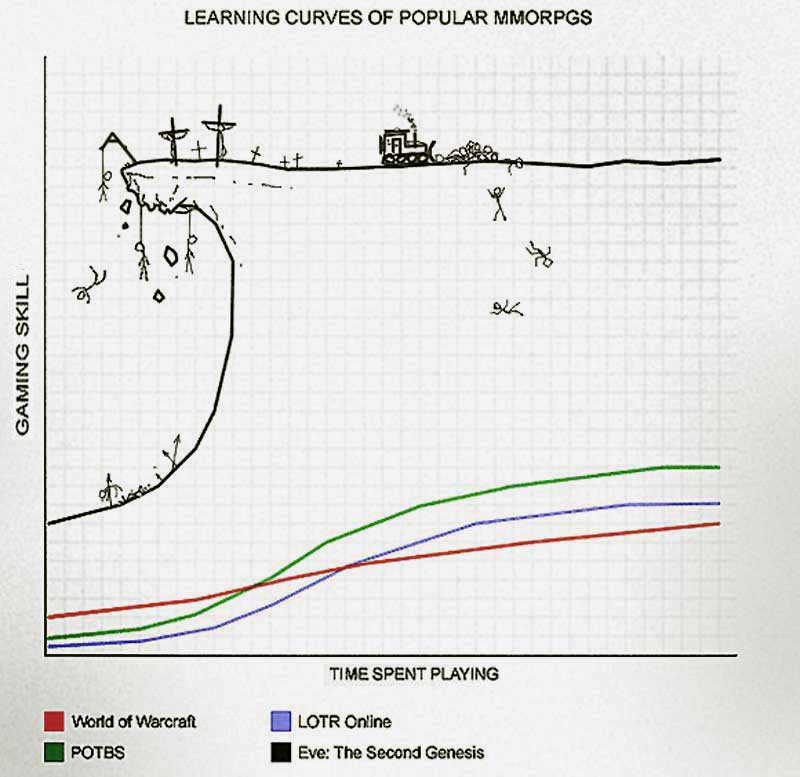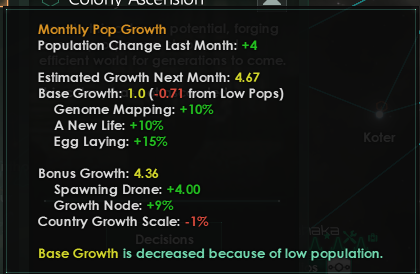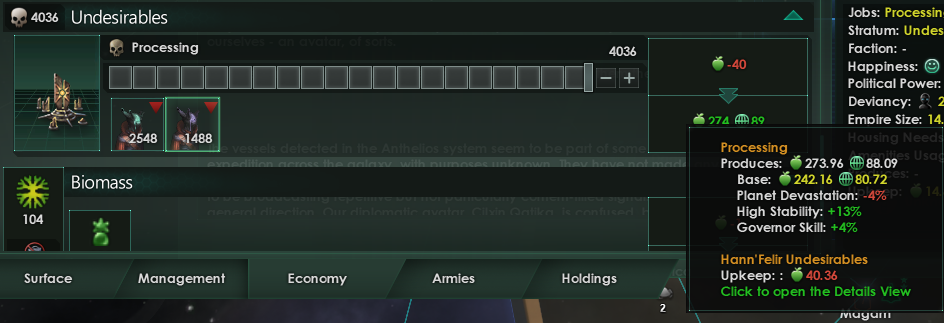First of all, this has been my general experience going straight in Stellaris 4.0+ as Wilderness (eve-online curve)

With that out of the way, here comes a TL: DR list as possible for better gameplay experience from my testing:
Growth
Colonization
Planet / Empire management

With that out of the way, here comes a TL: DR list as possible for better gameplay experience from my testing:
Growth
- Actual pop or biomass is correctly displayed in Outliner when you hover over planets or in the Empire size menu sections for pops. The biomass shown on planets always lags behind in calculations one or even two months unless you're doing something simple as building.
- Base pop growth is now 1.0 (not 3.0!), this means at PERFECT planet capacity vs number of pops (biomass), you can achieve at maximum +1,5 + modifiers pop growth per month. This requires +30% pop growth speed to match the +2 pop assembly from the Cradle of Rebirth. This also requires you to keep a sizeable chunk of biomass at each planet, meaning it will never be better to save biomass instead of building even a single Cradle of Rebirth.
- Ironically, the average minimum biomass you'd have to "resettle" to a new colony at around planet size 15-18 to not get less than 1 natural pop growth is around 400 biomass.
- The ROI in a Cradle of Rebirth is 400/2/12 = 16,67 years at default price. Do everything you can to reduce building cost to increase ROI.
- +Job effienciency affects Cradle of Rebirth, but not "+from jobs"-modifiers.
- "Smuggle Population" espionage mission is a good way to boost your biomass incoming without being a Devouring wilderness or having unlocked Genotype Regeneration in Purity ascension. Pop amount can be anywhere in between a full 100 ("1" pop, for example 223), this means 200 pops will randomly be assimilated over all your worlds over at least two months due to calculations and conversion into biomass. The leftover 23 pops in the example will be "saved" (seen in species tab) until you may get pass the threshold of 100 if you Smuggle Population again. Dunno if intended. Sometimes I've gotten less than 100 pops.
- +Biomass per month indicator in top bar does not reflect additional growth from assimilation when pops are turned into biomass, but it does happen.
Colonization
- There is a steep biomass cost when trying to colonize planets by transforming them into your native one. It's always better to simply colonize the planet at the lowest 500 biomass cost and then to terraform it with Energy credits after it have been colonized.
- The same can be done for much easier if you're going a Ocean starter world with Hydrocentric using Deluge Colossus weapon.
- After you've expanded your said planet to the maximum size of 30 using "Expand Planet Size" decision, you can expand the planet +3 more times using the aquatic counterpart.
- Hydrocentric and World Shaper ascension perks reduce the terraforming cost of -25% each. This will save you biomass.
Planet / Empire management
- It's generally a lot cheaper to build districts than buildings in terms of ROI per biomass.
- Buildings and upgrading buildings should mostly be do done mid/late game due to the biomass restriction.
- You should take every tradition to reducing empire size from colonies;
- Imperial Prerogative −50% Empire size from planets
- Expansion's Limited Autonomy −25% Empire Size from Systems −25% Empire Size from Planets,
- Purity's Heightened Attributes −25% Empire size from planets −25% Empire size from districts.
- Divided Attention civic −25% Empire size effect.
- Maybe even finishing Statecraft for -5% size.
- It's much cheaper to add the module that allow ships to grow into their upgraded version instead of building the upgraded version directly.
Last edited:
- 4
- 1
- 1




